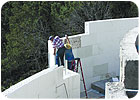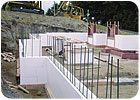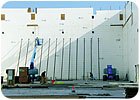
Expanded polystyrene (EPS) has been used as rigid foam insulation for more than 50 years. Over that time, technology advances and construction innovations have yielded new building products able to take better advantage of the material’s properties. Structural insulated panels (SIPs) and insulating concrete forms (ICFs) are two EPS systems introduced more than 30 years ago that are gaining widespread acceptance in North America. Increased energy costs and the recognized benefits of sustainable design have now firmly pushed them into the mainstream.
When first introduced, these building assemblies were viewed and marketed as totally separate systems-even competitors-positioning themselves as alternatives to traditional stick-built construction. However, designers are increasingly finding new ways to use both ICFs and SIPs in the same project, exploiting the best attributes of each.

Understanding ICFs
Insulating concrete forms are one of the fastest growing systems for foundations and above-grade walls in commercial and residential construction. The forms are available in a variety of shapes and sizes for use in foundations, basements, multiple-story dwellings, and commercial facilities.In ICF construction, lightweight foam forms are stacked atop one another, creating both an exterior and interior insulated wall. Installers then lay rebar horizontally and vertically inside the form to yield a structurally sound unit designed for the expected vertical- and lateral-loading conditions. For a perfectly square and plumb structure, the walls can be adjusted via pre-manufactured 45- and 90-degree corners. After proper installation and bracing, the forms are pumped full with concrete held to a 127 to 152-mm (5 to 6-in.) slump.
Once the walls have cured, they form an incredibly strong, non-deteriorating monolithic structure. Since the protective insulation helps provide an ideal curing environment, tests conducted by the Portland Cement Association (PCA) suggest the concrete can be stronger than what is cured in traditional systems.
Unlike traditional construction, ICF walls are continuous without thermal bridges-this can promote energy efficiency. Air barriers provided by the EPS insulation and concrete can help eliminate air infiltration, while the high thermal mass of the concrete walls can help buffer the home’s interior from extreme outdoor conditions, providing consistent indoor temperatures. The result can be a 25 to 50 percent energy savings over traditional wall and framing materials, along with the potential for considerable natural resource conservation.
In sound transmission tests, ICF walls can provide excellent performance, leading to quieter structures. An ICF system has a rating in excess of sound transmission class (STC) 55-this equates to efficient sound absorption properties.
Structural insulated panels
Typically used for wall, floor, or roof construction, structural insulated panels sandwich EPS foam between oriented strand boards (OSB). This panelized assembly can provide increased thermal protection over conventional frame construction. SIPs are available in various sizes and thicknesses, usually incorporating Type I EPS and ¼-inch OSB. Panels can range from 4 x 8 feet to 8 x 24 feet, while thicknesses can be made from 4.5 to 12.25 inches with insulating properties from an R-value of 15 to 45. This increase in resistance to heat flow illustrates the material’s abilities-the higher the R-value, the greater the insulating power.Due to its foam core, laminated sheathing, and excellent load-bearing capabilities, SIPs can be considered suitable for large-span roofing applications. The panels can reach great distances without the structural support often needed with conventional roofing materials. (This means the potential of more easily specifying and installing cathedral ceilings.) Additionally, tests have shown SIPs can withstand severe dimensional constraints and volatile indoor/outdoor temperature differences, while providing excellent thermal performance.

Thermal performance
When evaluating insulating performance criteria, R-value is the only variable taken into consideration. However, there are a host of other conditions contributing to the performance of the entire building envelope, including air infiltration, moisture, thermal mass, insulation settlement, and thermal drift. ICFs and SIPs effectively address all these issues, offering the performance attributes sought by designers concerned with rising energy costs and the importance of green design.Due to their monolithic assembly, ICFs can create a shell that inhibits air infiltration-there are no air leaks or drafts due to insulation settlement. The forms and concrete stay in place for the life of the structure and EPS rigid foam maintains its performance without experiencing thermal drift. SIPs also allow tight construction for eliminating air leakage - one of the most significant sources of a structure’s energy loss.
For example, the Cement Association of Canada (CAC) tested a home with ICFs above and below grade wall construction for air tightness. The 3,900-square foot structure was found to have an air leakage rate of 0.22 air changes per hour (acph), indicating reduced air infiltration compared to other wall assemblies.
The Northwest Territories Housing Corp. (NWTHC) conducted the same type of test on a SIP demonstration house, achieving a rating of 0.49 achp. Due to the air tightness of ICF/SIP construction, the designer must take into consideration building ventilation systems to maintain indoor air quality (IAQ) and humidity.
Testing has shown a roofing assembly’s expanded polystyrene insulation can retain its original thermal performance rating even after 15 years in situ. A more recent research study conducted by the National Research Council (NRC) of Canada confirmed these results-EPS sheathing was installed below grade, without protection for 180 days. Again, the foam exhibited no deterioration. Concrete encased with EPS foam has been repeatedly proven in the field to provide exceptional structural integrity under the harshest circumstances. Many homes constructed with ICFs in Florida withstood the hurricanes of 2004, and the Federal Emergency Management Agency (FEMA) promotes the use of ICF construction for safe rooms in hurricane- and tornado-prone areas.
The Insulating Concrete Form Association (ICFA) partnered with the U.S. military to conduct blast testing on ICFs. Stationary explosives were detonated at various distances from ICF walls resulting in minimal structural damage. (Additional testing is planned with Air Force personnel.) SIPs have also proven able to withstand high winds, snow loads, and seismic activity.
Design capabilities
Architects, engineers, and specifiers may be hesitant to incorporate innovative building assemblies due to restrictions on aesthetic design. Indeed, looking at ICFs, one might assume these blocks would lead to cookie-cutter construction. However, ICF manufacturers have developed various block-types to open up the possibilities of design. Anything imaginable-curves, angles, bows, and bays-can be created using the concrete forms.Once the concrete is poured, electrical contractors use ‘hot knives’ to cut holes, chases, and rectangles into ICFs to house cables and electrical wiring. The latter may require a metal sheath or conduit when installed in these routed channels, and electrical switch and receptacle boxes should be specified as shallow depth to fit within the EPS layer of the ICF wall.
Architects submit their SIP designs directly to the factory. Using CAD systems and high-end fabrication techniques, the panels are then manufactured to specification and delivered on-site, ready for immediate installation with detailed layout instructions. Door, window, and skylight openings may also be pre-cut. Even the most complicated, multi-faceted roof design can be accomplished in-house without wasting valuable time on-site.
All traditional exterior finishes including vinyl or wood siding, stucco, brick, stone, or-another EPS application-external insulation finish system (EIFS) can be used with ICFs. The same is true for SIPs.
To maximize the benefits offered by both systems, there are several design options architects can employ.
ICFs
ICFs may be used for below- and above-grade walls, while SIPs can be specified above the grade or for roofing applications. When using ICFs in below-grade walls and SIPs above grade, an anchor is embedded in the top layer of the forms and then secured to the bottom of the panel. Floor joists (perpendicular to the wall) may be installed in between the ICFs below the grade and the SIPs above. Again, an anchor is used to fasten the joists to the ICFs. To install structural insulated panels as the roof, a 2x6 stud is embedded in the top ICF form after the concrete has been poured, attaching the panels using long (10-inch) screws. Adding a SIP roof to SIP walls is straightforward. The National Association of Home Builders (NAHB) Research Center has identified several tips to assist contractors and designers when installing insulating concrete forms:1. Additional reinforcement is not necessarily better. Adding more reinforcement than required can hamper the proper placement and consolidation of concrete in ICFs.
2. Lintels (or concrete headers) should be as deep as possible. When the lintel span-to-depth ratio is greater than five, shear reinforcement or ‘stirrups’ are necessary. Stirrups can be difficult to place in insulating concrete forms and overuse can contribute to the concrete placement and consolidation problems mentioned above.
3. One should not specify very low slump concrete for use in the forms. Although this practice may slightly reduce the concrete strength, a slump rate of 6 is good for ICFs since it helps achieve better concrete consolidation in the forms.
4. The design professional may wish to consider laying out building dimensions, windows, and doors to correspond with the modular dimensions of the ICF materials being used. This design investment can improve labor efficiency and reduce waste, particularly in house plans that will be used repetitively.
5. Thicker walls should be accounted for in architectural plans and details, such as window jambs.
6. The contractor should understand appropriate concrete placement practices and forming details related to the specified ICF system. A poorly planned construction endeavor can reflect badly on the technology and the designer.
7. A team approach involving the contractor, builder, manufacturer, designer, and owner is encouraged. This means the entire team should be included in the process as soon as possible after the design concept stage.
8. Plumbing should be kept in the slab and routed through floor and interior wall cavities to the greatest extent possible.
9. Electrical wiring in the surface of ICF walls may need protection (e.g. metal sheathed or placed in conduit) when installed in routed channels of the foam forms using a hot knife (usually available through the manufacturer). Additionally, electric switch and receptacle boxes will need to be specified as shallow depth to fit within the foam layer of an ICF wall.
SIPs
SIPs are lightweight and, as such, easily carried and installed by hand. Pneumatic nailers are generally used to fasten the panels to top and bottom plates, and to make vertical connections. The panels must be braced and plumbed just as practiced with stud framing. Beams carrying roof loads may require supports incorporated into wall panels for carrying the point loads downward. Heavier roof panels are usually set in place with a crane. To ensure the insulating capacity of the SIPs, all joints must be sealed properly. The Structural Insulated Panel Association (SIPA) provides best practice connection diagrams for typical joints and details.Using SIPs in the installation of perimeter walls is not only easier and faster, but the interior gypsum wallboard and exterior siding installation is just as simple because there is no need to locate studs. Most panels include a formed chase in the core for electric wiring. The insets for boxes and additional channels must be mechanically routed, then resealed with expanding foam.
Green thinking
As the design and construction community integrates environment-related practices and government agencies implement legislation to foster green building initiatives, traditional products and systems are being re-evaluated. New products such as ICFs and SIPs are moving to the forefront thanks to their ability to leave a lighter footprint on the environment.Defining green products is not an exact science. Characterization of a sustainable material is difficult because product environmental attributes can be evaluated differently. As a result, there are numerous sources claiming to have the answers-from online databases to the U.S. Green Building Council’s (USGBC’s) Leadership in Energy and Environmental Design (LEED).
In actuality, all insulation materials can be considered ‘sustainable’ to a degree, thanks to their contributions to a structure’s energy efficiency. However, not all materials deliver significant enough attributes to classify them as “green”. The expanded polystyrene used in both ICFs and SIPs offers sustainable R-values throughout the structure’s life without thermal drift.
Additionally, many EPS providers incorporate recycled content-both post-consumer and post-industrial-into their manufacturing process. ICFs and SIPs also incorporate renewable products via the former’s concrete and the latter’s OSB panels.
Due to the extensive pre-planning process used in both ICFs and SIPs, on-site waste is also considerably reduced. With SIPs, an architect employs CAD drawings to determine the number and dimensions of panels needed for a job. The SIP manufacturer customizes the panels to the design before shipping them to the project. Installers can ‘build’ the home according to the numbered panels corresponding with the blueprints-no extra materials are needed or wasted. Reduced costs can also be realized through shorter construction schedules and lower labor costs due to ease of installation. Additionally, with minimal thermal bridges, air leakages are rarely a concern, as most outdoor pollutants are kept out.
Conclusion
ICF and SIP building systems have offered a viable alternative to traditional building methods. They provide the possibility of increased energy savings with flexible design elements and quicker construction practices. Many manufacturers have developed courses and certification opportunities for contractors to ensure installation guidelines are followed.Industry organizations are continuing to level the playing field with the other traditional construction systems through the development of prescriptive code standards for these building systems. Language developed for ICFs have been incorporated into the International Building Code (IBC) and International Residential Code (IRC), while the standard for SIPs is currently in the works.
